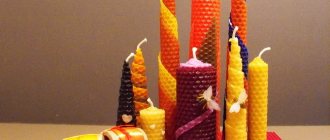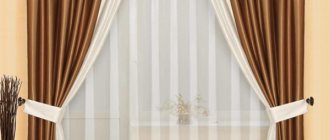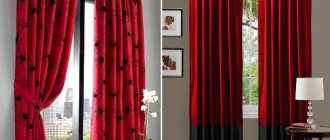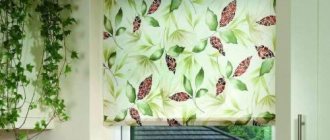The desire to hem curtains at home happens due to a variety of reasons, among which the need to save money or the desire to do something for the home with your own hands.
But even when ordering from professionals, it can be difficult to guess the length of tulle and curtains , since it is unknown how the finished product will look on the window.
If you do hemming at home, then many problems can be avoided , for example, even before cutting the fabric, select the desired length by trying on.
What you will need
The set of tools for carrying out the manipulation depends on the method of hemming the curtains. So, if shortening is done manually, you will need:
- scissors;
- centimeter;
- chalk;
- pins;
- thread;
- needle.
When the material is processed on a sewing machine, the specified set is used, but instead of the last two tools, the corresponding device is taken.
To shorten the length using adhesive tape, you will need a strip with an adhesive base and an iron.
How to process tulle on the sides
Three methods are used to process tulle on the sides:
- hem seam;
- using bias tape;
- Moscow seam.
Tulle made of organza, chiffon and nylon on the sides is not processed using an overlocker or a zigzag seam.
The hem stitch is suitable for any fabric. For nylon and organza, the width of the fold is 3 cm.
Tulle treated with bias tape looks original. It can be matched to the color of the curtains, or it can be in contrast. The main thing here is to do everything carefully. Bias binding is used to process fabrics with embroidery or mesh tulle.
It is not always possible to select a product from the assortment of ready-made curtain models that meets our tastes and requirements, and even fits harmoniously into the interior. It's a different matter when it comes to the choice of materials or the options offered with free length: a raw edge that is hemmed to the desired height.
- Finishing the edge of the curtain with a regular seam
- Treatment with adhesive tape
- Fabric edging
- Finishing the edges of organza and tulle
How to hem curtains from the bottom at home: step-by-step instructions describing the process
There are two ways to shorten curtains - trimming and folding. In the first case, you should measure the fabric correctly and cut the fabric to the required length. Before starting work you must:
- Wet the curtains and hang them on the curtain rod without squeezing them. Leave the textiles for 3 days. This will allow the fabric to sag and allow more accurate measurements to be taken.
- Select threads for curtains. They must match the shade of the material.
- Prepare suitable pins. Do not use thick tools as they leave holes in the fabric.
The shortening method and type of seam are chosen depending on the type of material:
- Tulle, organza, and other thin fabric can be set on fire. This will seal the threads and prevent them from unraveling. The main thing is to perform the procedure carefully so as not to set fire to the canvas.
- Dense material may bend after hemming. This problem often occurs with blackout fabric. To prevent the night curtain from losing its shape, a weighting agent is inserted into the bend. Usually a wooden plank is used. If the products were originally sold with a load, the length should be cut not from the bottom, but from the top. To prevent the curtain from losing its shape, curtain tape is sewn on.
- If the material crumbles, the edge is additionally treated with a zigzag seam. This will fix the threads and increase the service life of the fabric.
- Double-sided curtains cannot be hemmed in the usual way, as this disrupts the design of the canvas. Such curtains do not have a front or back side. In this situation, the textiles are cut, the edges are folded inward, and sewn with a hidden seam.
To shorten curtains, the following types of processing are distinguished:
- Classic seam. This is a straight stitch that is suitable for both light curtains and heavy curtains. The fabric is simply folded and stitched. If the material crumbles, make 2-5 bends.
- Blind seam. These are hidden stitches that are used to seamlessly join two warps together. They do not pierce the fabric with a needle, but make a small grab of the thread. This results in a neat hem.
- Using edging. When the curtain fabric is thick, it is not folded. If you fold the material and sew a seam, the edge will be too thick. He looks unattractive. In such a situation, excess fabric is removed, that is, the bottom is cut to the desired length. No allowance is left. The braid is sewn on with a hidden seam.
- Gusset. This is the most difficult way to shorten curtains, but after the procedure the products look aesthetically pleasing. The angle turns out to be neat, not too tight, and not puffy. This method can only be used by experienced dressmakers.
Processing the bottom of the curtain with a corner
Before starting the hemming process, you need to take measurements of the fabric. To carry out the procedure correctly, adhere to the following algorithm:
- Textiles are laid out on a flat surface. It's better to work on the floor.
- If the material is very wrinkled, it will be ironed.
- Use a centimeter or tape measure to measure the desired size.
Fabric trimming is performed only if the fabric is too long. If the size of the canvas is 10 cm larger than the required value, the textiles are simply folded and hemmed. This will allow the curtains to be returned to their original dimensions if necessary.
When the measurement has been made and the modeling method has been selected, they proceed directly to the procedure. This can be done in several ways.
Manually
This is the longest method of hemming curtains. It is usually used if you need to reduce the length of the curtains without removing them from the curtain rod.
Procedure:
- The curtains are measured. On the wrong side, use chalk to mark to what length the curtains need to be folded. If necessary, trim off the excess.
- They make a bend. The fabric is folded flat and ironed. Fasten with pins. For thick curtains, the material is folded only once. Tulle can be folded in 2-3 layers.
- Perform hemming. The main condition of this method is to leave a thread 2 cm long at the ends, and not thread it to the end, so as not to form a crease.
On a sewing machine
This is the fastest way to hem curtains. Algorithm:
- The fabric is folded and trimmed. Fasten with pins.
- Perform estimates.
- Textiles are sewn on a sewing machine.
- Remove the mark.
- The threads are tied into a knot at the ends.
Using adhesive tape
To bend curtains using this strip, proceed as follows:
- Measure the width of the canvas. This value must correspond to the length of the adhesive strip. If the indicators do not match, the procedure will not work.
- The curtain is folded. To fix the material, heat treatment of the canvas is performed.
- Adhesive tape is inserted into the crack. The top of the fabric is treated with a hot iron.
This method of shortening the length of curtains can only be used for light fabrics. The sticky strip will not support the weight of the dense material.
Using drawstring
You can decorate the top of the curtain at home using a drawstring. To do this, the top of the curtains is treated with a hem seam. Unsewn holes are left on the sides of the product, through which the cornice is inserted into the curtain. The width of the drawstring is equal to the volume of the cornice plus a few centimeters for the smooth sliding of the canvas along the cornice.
Features of processing the side edge of the curtain
It is important to properly process the edge of the curtain from the sides. This will preserve the integrity of the material and prevent it from falling off.
Methods of carrying out the procedure:
- Overlock processing. This will help fix the threads and prevent the fabric from fraying. For reliability, the material is folded and hemmed with a regular seam.
- Fixing the adhesive tape. As already mentioned, it is inserted into the fracture and heat treatment is performed.
- Edging with lace, braid, etc. Measure the required length of the product. The edge of the fabric is inserted inside the part, the fabric is stitched.
Using eyelets
Types of processing for the top of curtains include the option of using eyelets. These are special rings that are inserted into the upper part of the product and then put on the cornice pipe. In order to independently secure the eyelets on the curtain, you first need to glue rigid braid and decorative edging to the canvas. After this, holes are cut at a uniform distance on the compacted area of the canvas. The diameter of the holes corresponds to the size of the eyelet rings. Do not forget that the number of eyelets used on one curtain must be even. Only under this condition will the fabric be distributed evenly.
Is it possible not to hem the curtain?
In order not to carry out the corresponding procedure, you can use alternative methods of shortening curtains:
- Form vertical folds. This method is suitable for tulle, organza, and other thin fabrics. Waves are made either from both ends of the curtains or across the entire width at the same distance from each other. First, strips are drawn and threads are pulled along them. One end is pulled so that the fabric gathers into a fold. Tie a knot.
- Fix a narrow curtain tape. This option is suitable for both heavy curtains and tulle. The textile strip adjusts the length and maintains the shape of the fabric.
- Use of grabs. They allow you to reduce the size of the curtains, but at the same time fix the curtains in one position.
To shorten the curtain to the desired length, you need to cut the fabric and fold it. Next, the material is stitched on a sewing machine or hemmed by hand. You can also use duct tape. To do this, the strip is placed in a fold and ironed on top. To adjust the length of the canvas, it is not necessary to bend it from below. You can form vertical folds, sew on curtain tape, or use other methods.
Loop decorations
The curtains with hinges in the photo look original. The configuration, size and color of the loops depend on the model of the curtain and the size of the cornice. It is not difficult to process the top of the curtain with loops. You should select a suitable material that will be in harmony with the fabric of the product in color and texture, and cut out loops from it for attaching the curtains. The loops can be velcroed and unfastened if necessary.
An alternative option could be ties. The knot, which is located on top of the cornice, will additionally decorate the window opening. If the loops seem banal to you, decabols will help you decorate them. These are decorative rings through which curtain loops are threaded. Decabolas can be contrasting or identical in color to the curtains.
Original version
Today, many housewives are trying to get away from the usual, sometimes boring methods of finishing the tops of curtains. One of the modern methods of decorating curtains is the use of decorative rings and hooks. In this case, cornices are not used. The main, stationary fastening elements are holders or hooks that are fixed to the wall. The curtain is equipped with ropes, ribbons or rings. Moreover, the places where the elements are attached to the curtain itself can be arbitrary. It all depends on how the housewife sees the design model of the window opening. In this case, you can create glasses and drapery of different depths and splendor with your own hands.
Thus, answering the question of how and with what to decorate the top of the curtains, you can choose one of the proposed options. The design of the top trim depends entirely on the model of the curtain, as well as on the style and color scheme in which the product is made. If you need to emphasize the elegance of curtains, it is better to give preference to braid and lambrequin. Curtains with Velcro loops in a bright design will look great in children's rooms. The kitchen and living room can be decorated with curtains on grommets.
The best posts
- We sew double-sided curtains with our own hands
- Wood plaster: finishing features and its technology
- Flat slate - characteristics, scope, installation
- How to sheathe the outside of a house made of log or aerated concrete
- Knitted house. Towel rack
- Knitted cap for amigurumi boy
- Crochet. Backpack bag for a student
- Knitting bactus with an openwork edge with knitting needles
Related article: Putty for OSB boards and technology for its application
Types of ribbons for creating drapery
There are many of them, and each type makes it possible to create certain folds at the discretion of the housewife. For example, there may be such curtain tapes:
1. For proportional collection of folds over the surface. Has pockets evenly distributed along the length. Using special hooks, tucks are created along the surface of the fabric.
2. Braid using cords for assembly. It is sewn to the very top of the fabric, then the cords are pulled together to the required size and secured.
3. Ribbons forming bows. The condition for the formation is the width of the curtain, which should be three times wider than the cornice.
4. Ribbons forming bows. The size of the curtain is chosen 2.5 times wider than the length of the cornice.
5. A narrow ribbon that is attached to the top of the curtain and forms small folds due to two elastic bands built into it. It is calculated that the curtain is 2 times wider than the length of the cornice, but its size should not exceed 158 cm.
6. Ribbon with tucks. In this case, the ratio of the size of the curtain to the cornice is calculated as three to one.
7. The tape is wide. It is used when you need to get pencil folds - narrow, but quite long.
8. Tapes used in Roman blinds are equipped with rings, as well as a cord on which there are loops. Attaches to blinds.
9. Ribbon with rings attached to it. The rings are made of plastic, sewn at a certain interval. The tape itself is attached to the blinds vertically from the wrong side. A cord will be pulled through all the rings.











